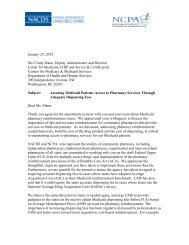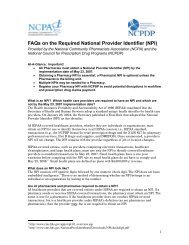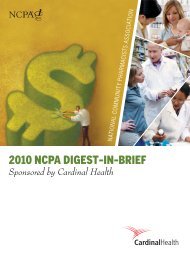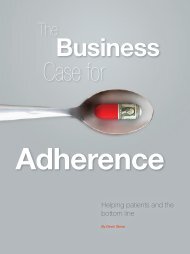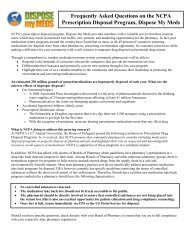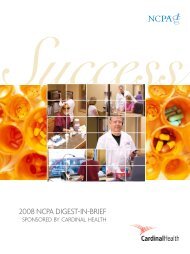NATIONAL COMMUNITY PHARMACISTS ASSOCIATION
NATIONAL COMMUNITY PHARMACISTS ASSOCIATION
NATIONAL COMMUNITY PHARMACISTS ASSOCIATION
- No tags were found...
Create successful ePaper yourself
Turn your PDF publications into a flip-book with our unique Google optimized e-Paper software.
Common-Sized Balance SheetThe balance sheet represents the most important informationabout a business with respect to its financial healthand its ability to continue operations. While the incomestatement measures performance for one year, the balancesheet displays the financial condition of the business afterall its years of operations. The two sides of the balancesheet are:n Assets—what the business owns.n Liabilities and Net Worth—what the business owes (tothose who supplied the funds to buy the assets—thecreditors and the owners).The key financial issues related to the balance sheet includesolvency, liquidity, risk and efficiency of generating sales,profits and cash flow from assets.Performance MeasuresFinancial performance is measured by making comparisonsbetween items found on the income statement orbalance sheet, and sometimes by using other non-financialstatistics. Comparing one number to another produces aratio. This report contains a number of ratios designed toevaluate the financial health of a independent communitypharmacy. For an explanation of how specific ratios arecalculated and interpreted, refer to the Guide to Benchmarking.The Guide is designed to be an informative companionpiece to the Digest and can be downloaded fromthe Digest section of the NCPA web site at www.ncpanet.org/members/digest.php.For purposes of this report, financial performance is measuredin these four critical areas:n Profitability—gross profits, net profits, and expense controln Productivity—staff and facilitiesprofit margin and net operating income percentage.Expense controls improve profitability, so expenses andgroups of expenses are also monitored (as a percentageof sales). The Digest’s reporting of profitability, both inpercentage and dollars, is after compensation to ownersbut before tax.Productivity—Managing efficiency of staff and facilitiesMaintaining reasonable levels of staff for a given sales volumeand controlling payroll expenses represents a key areaof financial efficiency. Optimum productivity is the resultof efficiency in payroll expense control, balanced with effectivenessof staff’s efforts. Staff cost per employee or asa percentage of sales are benchmarks for measuring costefficiency. Sales per employee is a benchmark for measuringthe effectiveness of staff efforts. Sales per square footmeasures the productivity of facility space.Financial Position—Balance sheet management andefficiency of generating sales and profits from your investmentin assetsEfficiency of asset use can be measured by comparing salesto assets. The return on investment ratios measure howefficiently the companies generate profit from the owners’investment. Debt management is measured by the debt toworth ratio.Cash Flow Management—Managing the uses of cash andliquid assets in the ongoing operations of the businessInventory, accounts receivable, and accounts payableproblems are controllable, and management efficienciesin these areas can be measured. The common benchmarksfor measuring these efficiencies are inventory turnover andturn days, accounts receivable turnover and turn days, andaccounts payable turnover and turn days. The liquidity,or short-term solvency of the business, is measured by thecurrent and quick ratios.n Financial position—asset use and managing debtn Cash flow—managing the elements of the workingcapital cycleProfitability—Efficiency in generating profits from salesSavings through managing cost of goods sold fall straightto the bottom line as increased net profits. Other opportunitiesfor increased profitability come from controllingpayroll expenses, operating expenses, and interest expense.Benchmarks for measuring profitability include gross422009 NCPA Digest, sponsored by Cardinal Health



